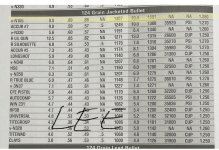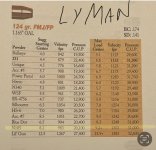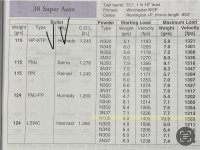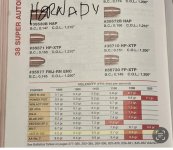I changed the recoil spring in my .38 Super 1911 to a 15 lb. Spring that is recommended for full power .38 Super loads. The guy I bought it from used it in competition and had a very light spring in it. I wanted to use some VV N-105 that I had on hand, as it seemed like I could get into the fps range I wanted pretty easily. I always compare loads across a few manuals to see if they're all on the same page, so to speak. I'm looking to load some 124 grain jacketed flat point bullets. The ranges I see in the manuals have a fairly wide variance. The VV and Lee ranges are similar to each other, as are the Hornady and Lyman, but differ significantly from each other.
Here are the numbers:
Start Max/do not exceed
Hornady. 8.2 gr. 8.9 gr.
Lyman. 8.2 gr. 9.2 gr.
Lee. 9.9 gr. 10.4 gr.
Vihtavuori 9.9 gr. 10.9 gr.
There is a full 2.0 gr. difference between Hornady max and VV max. These are all .38 Super and not Super Comp.
What do the experts say?
Here are the numbers:
Start Max/do not exceed
Hornady. 8.2 gr. 8.9 gr.
Lyman. 8.2 gr. 9.2 gr.
Lee. 9.9 gr. 10.4 gr.
Vihtavuori 9.9 gr. 10.9 gr.
There is a full 2.0 gr. difference between Hornady max and VV max. These are all .38 Super and not Super Comp.
What do the experts say?




